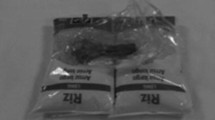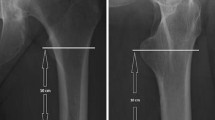Abstract
Background
Osteoporotic fractures of the proximal humerus show an increasing incidence. Osteoporosis not only influences the fracture risk after low-energy trauma, but also affects the mechanical stability of internal fixation. Preoperative assessment of the local bone quality may be useful in the surgical treatment of patients sustaining these injuries. The aim of the present study was to present a method for the preoperative assessment of the local cancellous bone mineral density (BMD) of the proximal humerus using CT data.
Methods
In the first part of the study, CT scans of 30 patients with unilateral fractures of the proximal humerus after low-energy trauma were used. The local BMD was assessed on the contralateral uninjured side. All 30 patients additionally underwent dual-emission X-ray absorptiometry (DXA) of the lumbar spine, proximal femur, and forearm of the side of the uninjured proximal humerus within 6 weeks after trauma. Three independent trauma surgeons performed measurements on the uninjured proximal humerus twice with a time interval of 4 weeks in order to assess the inter- and intraobserver reliability of the method. In the second part of the study, the local BMD of 507 patients with either proximal humerus fractures or chronic shoulder instability was assessed by a single trauma surgeon. In both parts, the average HU values in standardized ROIs of the humeral head were automatically calculated after correcting for HU values below the water equivalent. A linear calibration equation was computed for the calculation from HU to BMD using a calibration device (EFP).
Results
The intra- and interobserver reliability was high (ICC > 0.95). Correlation coefficients between the local BMD of the proximal humerus and other anatomical sites were between 0.35 (lumbar spine) and 0.64 (forearm). We found a high correlation between the local BMD and age. The BMD in the fracture group was significantly lower than in the instability group. These patients were significantly older and more likely to be female.
Conclusion
Our method may provide a preoperative tool for the assessment of the local bone quality of the proximal humerus using CT data. Therapeutic adjustments such as augmentation or primary arthroplasty may be considered in patients with very low local BMD.



Similar content being viewed by others
References
Palvanen M, Kannus P, Niemi S, Parkkari J. Update in the epidemiology of proximal humeral fractures. Clin Orthop Relat Res. 2006;442:87–92.
Kannus P, Palvanen M, Niemi S, Parkkari J, Jarvinen M, Vuori I. Osteoporotic fractures of the proximal humerus in elderly Finnish persons: sharp increase in 1970–1998 and alarming projections for the new millennium. Acta Orthop Scand. 2000;71:465–70.
Seebeck J, Goldhahn J, Stadele H, Messmer P, Morlock MM, Schneider E. Effect of cortical thickness and cancellous bone density on the holding strength of internal fixator screws. J Orthop Res. 2004;22:1237–42.
Seebeck J, Goldhahn J, Morlock MM, Schneider E. Mechanical behavior of screws in normal and osteoporotic bone. Osteoporos Int. 2005;16:107–11.
Hertel R. Fractures of the proximal humerus in osteoporotic bone. Osteoporos Int. 2005;16:65–72.
Owsley KC, Gorczyca JT. Fracture displacement and screw cutout after open reduction and locked plate fixation of proximal humeral fractures. J Bone Joint Surg Am. 2008;90:233–40.
Ring D. Current concepts in plate and screw fixation of osteoporotic proximal humerus fractures. Injury. 2007;38:59–68.
Sperling JW, Cuomo F, Hill JD, Hertel R, Chuinard C, Boileau P. The difficult proximal humerus fracture: tips and techniques to avoid complications and improve results. Instr Course Lect. 2007;56:45–57.
Reeve J, Kroger H, Nijs J, Pearson J, Felsenberg D, Reiners C, et al. Radial cortical and trabecular bone densities of men and women standardized with the European Forearm Phantom. Calcif Tissue Int. 1996;58:135–43.
Gluer CC, Genant HK. Impact of marrow fat on accuracy of quantitative CT. J Comput Assist Tomogr. 1989;13:1023–35.
Laval-Jeantet AM, Roger B, Bouysee S, Bergot C, Mazess RB. Influence of vertebral fat content on quantitative CT density. Radiology. 1986;159:463–6.
Diederichs G, Korner J, Goldhahn J, Linke B. Assessment of bone quality in the proximal humerus by measurement of the contralateral site: a cadaveric analyze. Arch Orthop Trauma Surg. 2006;126:93–100.
Eckstein F, Lochmuller EM, Lill CA, Kuhn V, Schneider E, Delling G, et al. Bone strength at clinically relevant sites displays substantial heterogeneity and is best predicted from site-specific bone densitometry. J Bone Miner Res. 2002;17:162–71.
Groll O, Lochmuller EM, Bachmeier M, Willnecker J, Eckstein F. Precision and intersite correlation of bone densitometry at the radius, tibia and femur with peripheral quantitative CT. Skeletal Radiol. 1999;28:696–702.
Kannus P, Leppala J, Lehto M, Sievanen H, Heinonen A, Jarvinen M. A rotator cuff rupture produces permanent osteoporosis in the affected extremity, but not in those with whom shoulder function has returned to normal. J Bone Miner Res. 1995;10:1263–71.
Ramnemark A, Nyberg L, Lorentzon R, Englund U, Gustafson Y. Progressive hemiosteoporosis on the paretic side and increased bone mineral density in the nonparetic arm the first year after severe stroke. Osteoporosis Int. 1999;9:269–275.
Goutallier D, Postel JM, Bernageau J, Lavau L, Voisin MC. Fatty muscle degeneration in cuff ruptures. Pre- and postoperative evaluation by CT scan. Clin Orthop Relat Res. 1994;304:78–83.
Goutallier D, Postel JM, Gleyze P, Leguilloux P, Van Driessche S. Influence of cuff muscle fatty degeneration on anatomic and functional outcomes after simple suture of full-thickness tears. J Shoulder Elbow Surg. 2003;12:550–4.
Doetsch A, Faber J, Lynnerup N, Waetjen I, Bliddal H, Danneskiold-Samsoe B. Bone mineral density measurement over the shoulder region. Calcif Tissue Int 2002;71:308–314.
Tingart M, Apreleva M, Von Stechow D, Zurakowski D, Warner J. The cortical thickness of the proximal humeral diaphysis predicts bone mineral density of the proximal humerus. J Bone Joint Surg. 2003;85:611–617.
Homminga J, McCreadie BR, Ciarelli TE, Weinans H, Goldstein SA, Huiskes R. Cancellous bone mechanical properties from normals and patients with hip fractures differ on the structure level, not on the bone hard tissue level. Bone. 2002;30:759–64.
Homminga J, Van-Rietbergen B, Lochmuller EM, Weinans H, Eckstein F, Huiskes R. The osteoporotic vertebral structure is well adapted to the loads of daily life, but not to infrequent "error" loads. Bone. 2004;34:510–6.
Genant HK, Engelke K, Prevrhal S. Advanced CT bone imaging in osteoporosis. Rheumatology. 2008;47:iv9–iv16.
Author information
Authors and Affiliations
Corresponding author
Rights and permissions
About this article
Cite this article
Krappinger, D., Roth, T., Gschwentner, M. et al. Preoperative assessment of the cancellous bone mineral density of the proximal humerus using CT data. Skeletal Radiol 41, 299–304 (2012). https://doi.org/10.1007/s00256-011-1174-7
Received:
Revised:
Accepted:
Published:
Issue Date:
DOI: https://doi.org/10.1007/s00256-011-1174-7




